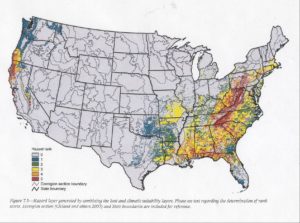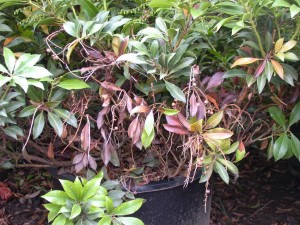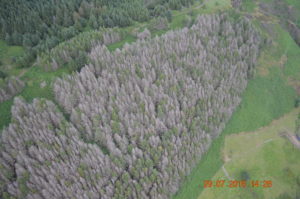P. ramorum-infected rhododendron
Jennifer Parke, Oregon State University
The USDA Animal and Plant Health Inspection Service (APHIS) is proposing to update its regulations intended to prevent spread of the sudden oak death (SOD) pathogen (Phytophthora ramorum) via movement of nursery stock. The proposal would incorporate into formal regulations several changes made through temporary “Federal Orders” issued in 2014 and 2015. The deadline for comments is August 24. Copies of the proposal and the on-line instructions to comment are located here.
[Federal Orders are issued by APHIS without going through the usual regulatory process. Federal Orders take effect immediately. Federal Orders are issued by the APHIS Deputy Administrator under the authority of the Plant Protection Act Section 412(a), 7 U.S.C. 7712(a). The Act authorizes the Secretary of Agriculture to prohibit or restrict the movement in interstate commerce of any plant, plant part, or article if the Secretary determines the prohibition or restriction is necessary to prevent the dissemination of a plant pest within the United States. Federal Orders also apparently modify existing regulations promulgated under the PPA and found in the Code of Federal Regulations.]
[I stated my objections to the relaxed approach under the Federal orders back in 2015; see my blog here .]
While I applaud APHIS’ decision to focus on nurseries, I have serious concerns about several aspects of the existing program that APHIS now proposes to formalize in the new regulation. I will ask that the following changes be made before the rules are made final. Please consider doing the same.
The Problems
1) APHIS should use this regulatory action to mandate sampling at all nurseries selling SOD host or “associated host” plant taxa
APHIS does not have any system for detecting P. ramorum in nurseries not previously suspected to harbor the pathogen. Instead, APHIS and its state cooperators inspect only those nurseries at which infected plants have been detected in recent years. This is a major weakness in the existing regulation and in the proposal. APHIS cannot limit the spread of SOD without periodically surveying nurseries outside the quarantine zone that contain or sell host or associated host taxa but where P. ramorum has not already been found.
History shows that unexpected nurseries can become infected. In 2012, half of the infected nurseries identified by regulators were infected for the first time. (These nursery infections were detected as a result of “trace-forwards” of infected plants shipped by wholesale nurseries.) Detection of all infected nurseries is vital to identifying the nurseries that were the original source of infection through trace-back. Also, finding infections early provides the best chance to protect the environment in which the infected nursery operates and in which its plants are used.
1(a) It is particularly important to survey nurseries within climate zones that support the pathogen.
It is well established that environmental conditions along parts of the Pacific coast of California, Oregon, and probably Washington are especially conducive to persistence and spread of P. ramorum. Certain regions of eastern states also appear to have climatic conditions conducive to survival of the pathogen – as documented in the several risk maps prepared over the past two decades.  Such areas would be smaller than the old “regulated areas” (see below), and more closely tied to climate zones – but larger than the actual quarantine zone.
Such areas would be smaller than the old “regulated areas” (see below), and more closely tied to climate zones – but larger than the actual quarantine zone.
[Under the pre-2014federal regulations, certain geographic regions were designated as “regulated areas”. These areas were defined as those in which P. ramorum has been found on nursery stock in commercial nurseries, but not found in the natural environment. These “regulated areas” included those parts of California and Oregon that are not inside quarantined areas, as well as the entire State of Washington. Under the 2014 and 2015 Federal Orders, APHIS has already dropped this geographic designation, and now focuses regulations only on nurseries at which infected plants have been detected in recent years.]
2) APHIS needs to set a more protective level of risk.
APHIS tries to persuade us that the current regulations have reduced the risk of spread of P. ramorum via the nursery trade to a low risk. As proof, APHIS says that over a nine-year period (2004 – 2013), APHIS and the state plant protection authorities detected P. ramorum at a “very small percentage—usually no more than 3 percent annually” of nurseries inspected under the current program. However, an annual level of risk of three percent is not a low level of risk. According to Daniel Botkin, the risk of death arising from certain activities recognized as high risk are all well below three percent. For example, the risk of dying from smoking cigarettes or driving racing cars is less than 0.5% (1/2 of a percent). For this reason, I am not convinced that the risk of SOD spread via the nursery trade has been suppressed to the extent necessary to protect our native flora or the financial health of nurseries.
3) All inspection protocols should be based on sampling and testing of water, soil, growing media, pots, plants as well as plants (leaves, stems, roots). They should not rely only on visual inspection of plants.
The APHIS proposal continues to rely too much on visual inspection of plants for symptoms – despite decades of experience demonstrating the inadequacies of that approach. It is essential that surveys, inspections, compliance reviews, etc., rely on sampling and testing of water, soil, growing media, pots, etc.
4) Updates to the list of hosts should be Comprehensive
In the proposed regulation, APHIS states its intention to update the lists of hosts and “associated hosts”. However, the proposal does not include more than a dozen species growing in the wild or in gardens in the Pacific Northwest that scientists have identified as hosts of P. ramorum. These include several species of manzanita, Pacific dogwood, huckleberries, a Trillium, and the common garden groundcover Vinca.
A particularly puzzling gap is APHIS’ intention to name Japanese larch (Larix kaempferi) as only an “associated” host. It appears that APHIS has not accepted the peer-reviewed work of British scientists and the well-documented severe damage caused to this species in the United Kingdom.
Larch killed by P. ramorum in Wales; Wales Natural Resources
Less important, probably, but still annoying is APHIS’ failure to complete Koch’s postulates to clarify the host status of 89 species now listed as “associated hosts”. Since APHIS regulates “associated hosts” in the nursery trade in the same way as it regulates recognized hosts, the failure to act does not affect the regulatory regime. However, it does cause unnecessary confusion and undermines the scientific foundation of regulations.
Please Comment
I strongly suggest that readers submit comments on the proposed rule. At a minimum, ask that the new regulation incorporate the most current science regarding detection and management of Phytophthora ramorum. Simply codifying the years-oldFederal Orders without recognizing more recent information and developments would not serve anyone. I suggest objecting particularly to continued reliance on visual inspection of plants rather than the sampling and testing protocols developed through 20 years of experience in managing this difficult pathogen.
Posted by Faith Campbell
We welcome comments that supplement or correct factual information, suggest new approaches, or promote thoughtful consideration. We post comments that disagree with us — but not those we judge to be not civil or inflammatory.

